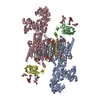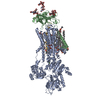+ Open data
Open data
- Basic information
Basic information
| Entry | Database: PDB / ID: 8jfz | |||||||||
|---|---|---|---|---|---|---|---|---|---|---|
| Title | Cryo-EM structure of Na+,K+-ATPase in the E1.Mg2+ state. | |||||||||
 Components Components |
| |||||||||
 Keywords Keywords | MEMBRANE PROTEIN / ion pump / P-type ATPase | |||||||||
| Function / homology |  Function and homology information Function and homology informationregulation of monoatomic ion transport / P-type sodium:potassium-exchanging transporter activity / sodium:potassium-exchanging ATPase complex / sodium ion export across plasma membrane / intracellular potassium ion homeostasis / intracellular sodium ion homeostasis / potassium ion import across plasma membrane / ATPase activator activity / sodium channel regulator activity / monoatomic ion transport ...regulation of monoatomic ion transport / P-type sodium:potassium-exchanging transporter activity / sodium:potassium-exchanging ATPase complex / sodium ion export across plasma membrane / intracellular potassium ion homeostasis / intracellular sodium ion homeostasis / potassium ion import across plasma membrane / ATPase activator activity / sodium channel regulator activity / monoatomic ion transport / proton transmembrane transport / ATP hydrolysis activity / ATP binding / membrane / metal ion binding / plasma membrane Similarity search - Function | |||||||||
| Biological species |  Squalus acanthias (spiny dogfish) Squalus acanthias (spiny dogfish) | |||||||||
| Method | ELECTRON MICROSCOPY / single particle reconstruction / cryo EM / Resolution: 3.5 Å | |||||||||
 Authors Authors | Kanai, R. / Vilsen, B. / Cornelius, F. / Toyoshima, C. | |||||||||
| Funding support |  Japan, 2items Japan, 2items
| |||||||||
 Citation Citation |  Journal: FEBS Lett / Year: 2023 Journal: FEBS Lett / Year: 2023Title: Crystal structures of Na ,K -ATPase reveal the mechanism that converts the K -bound form to Na -bound form and opens and closes the cytoplasmic gate. Authors: Ryuta Kanai / Bente Vilsen / Flemming Cornelius / Chikashi Toyoshima /   Abstract: Na ,K -ATPase (NKA) plays a pivotal role in establishing electrochemical gradients for Na and K across the cell membrane by alternating between the E1 (showing high affinity for Na and low affinity ...Na ,K -ATPase (NKA) plays a pivotal role in establishing electrochemical gradients for Na and K across the cell membrane by alternating between the E1 (showing high affinity for Na and low affinity for K ) and E2 (low affinity to Na and high affinity to K ) forms. Presented here are two crystal structures of NKA in E1·Mg and E1·3Na states at 2.9 and 2.8 Å resolution, respectively. These two E1 structures fill a gap in our description of the NKA reaction cycle based on the atomic structures. We describe how NKA converts the K -bound E2·2K form to an E1 (E1·Mg ) form, which allows high-affinity Na binding, eventually closing the cytoplasmic gate (in E1 ~ P·ADP·3Na ) after binding three Na , while keeping the extracellular ion pathway sealed. We now understand previously unknown functional roles for several parts of NKA and that NKA uses even the lipid bilayer for gating the ion pathway. | |||||||||
| History |
|
- Structure visualization
Structure visualization
| Structure viewer | Molecule:  Molmil Molmil Jmol/JSmol Jmol/JSmol |
|---|
- Downloads & links
Downloads & links
- Download
Download
| PDBx/mmCIF format |  8jfz.cif.gz 8jfz.cif.gz | 520.9 KB | Display |  PDBx/mmCIF format PDBx/mmCIF format |
|---|---|---|---|---|
| PDB format |  pdb8jfz.ent.gz pdb8jfz.ent.gz | 412.8 KB | Display |  PDB format PDB format |
| PDBx/mmJSON format |  8jfz.json.gz 8jfz.json.gz | Tree view |  PDBx/mmJSON format PDBx/mmJSON format | |
| Others |  Other downloads Other downloads |
-Validation report
| Summary document |  8jfz_validation.pdf.gz 8jfz_validation.pdf.gz | 3.2 MB | Display |  wwPDB validaton report wwPDB validaton report |
|---|---|---|---|---|
| Full document |  8jfz_full_validation.pdf.gz 8jfz_full_validation.pdf.gz | 3.3 MB | Display | |
| Data in XML |  8jfz_validation.xml.gz 8jfz_validation.xml.gz | 99.8 KB | Display | |
| Data in CIF |  8jfz_validation.cif.gz 8jfz_validation.cif.gz | 144 KB | Display | |
| Arichive directory |  https://data.pdbj.org/pub/pdb/validation_reports/jf/8jfz https://data.pdbj.org/pub/pdb/validation_reports/jf/8jfz ftp://data.pdbj.org/pub/pdb/validation_reports/jf/8jfz ftp://data.pdbj.org/pub/pdb/validation_reports/jf/8jfz | HTTPS FTP |
-Related structure data
| Related structure data |  36220MC  8jbkC  8jblC  8jbmC C: citing same article ( M: map data used to model this data |
|---|---|
| Similar structure data | Similarity search - Function & homology  F&H Search F&H Search |
- Links
Links
- Assembly
Assembly
| Deposited unit | 
| |||||||||||||||||||||||||||||||||||||||||||||||||||||||||||||||||||||||||||||||||||||||||||||||||||||||||||||||||||||||||||||
|---|---|---|---|---|---|---|---|---|---|---|---|---|---|---|---|---|---|---|---|---|---|---|---|---|---|---|---|---|---|---|---|---|---|---|---|---|---|---|---|---|---|---|---|---|---|---|---|---|---|---|---|---|---|---|---|---|---|---|---|---|---|---|---|---|---|---|---|---|---|---|---|---|---|---|---|---|---|---|---|---|---|---|---|---|---|---|---|---|---|---|---|---|---|---|---|---|---|---|---|---|---|---|---|---|---|---|---|---|---|---|---|---|---|---|---|---|---|---|---|---|---|---|---|---|---|---|
| 1 | 
| |||||||||||||||||||||||||||||||||||||||||||||||||||||||||||||||||||||||||||||||||||||||||||||||||||||||||||||||||||||||||||||
| 2 | 
| |||||||||||||||||||||||||||||||||||||||||||||||||||||||||||||||||||||||||||||||||||||||||||||||||||||||||||||||||||||||||||||
| Noncrystallographic symmetry (NCS) | NCS domain:
NCS domain segments: Ens-ID: ens_1
|
 Movie
Movie Controller
Controller



 PDBj
PDBj







 gel filtration
gel filtration